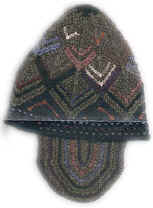


A couple of years ago, a friend sent me some skeins of her handspun yarn. I was taken by one in particular: a blend of brownish wool, bombyx noil, and multicoloured sparkly stuff, which she identified as trilobal nylon. What I love about this skein is how the nylon sparkles and shines in certain light, like the glimmer or shine on a mallard duck's back when the light hits it from a certain angle. In a later conversation, my friend commented that this kind of yarn would be really interesting in a heavily cabled sweater; as the yarn turned and twisted in the cables there would be many possibilities for reflective surfaces lots of sparkle and shine. I filed that comment in the back of my mind, along with my desire to try spinning this magical yarn.
One of the internet knitting lists to which I subscribe was holding a hat exchange. I'd been working with books by Horst Schulz and was intrigued by his use of different stitch textures and geometric shapes to build fabric pieces. The books are written in German, and I'd been puzzling my way through the descriptions and charts. It occurred to me that this might be a use for that glittery yarn. Rows of stitches would certainly be going off in a variety of directions, and purl stitch bumps would sit above the smooth fabric of stocking stitch. And the hat wasn't a big project! Seemed perfect, and my exchange partner, Denise, was pleased to be the recipient of an experiment which could easily result in a one-of-a-kind hat. I'd been spinning for less than two years at this point, and owned only a couple of suspended spindles no wheel (yet!). Nor had I tools for blending fibres. My friend said that the top she'd used for that magical yarn was no longer being produced, but I could imitate it with commercially prepared tops. Take wool, silk and nylon, stack them up, and draft them out until the resulting roving is as thick as I want. I figured I could knit a hat with about 4 ounces of yarn so I ordered that much superwash merino top. The silk and nylon were sold in 1 and ½ ounce units respectively, so I bought one of each. Ignoring the fact that I actually had no real idea what I was doing, I thought "Piece o' cake." How difficult could this really be?
Well, ignorance is not always bliss. The tops drafted out in clumps, rather than forming an even blend; I knew this couldn't create anything like my friend's beautiful yarn. But when I plied the sample I really liked how the colours recombined, and decided to continue with it. I did my best to spin consistently and match my sample but there's lots of room for variation in twist insertion when using spindles. And I learned some things about the different fibres when drafting: visually-equal amounts of wool, silk and nylon don't create the same grist of single, and things get really complicated when the fibres blend in many different proportions. So the singles had lots of thick and thin places, and the plied yarn has as well. Friends tried to cheer me up about this by saying I had made a "Fabulous, Expensive-looking Designer Yarn". I wondered how it would knit up. Could I find a suitable gauge given the variations in the yarn's thickness?
Knitting the hat was considerably easier at least for me as I knit better than I spin. I'd decided that the hat would be shaped like a ch'ullu, the hat of the peoples of the Andes mountains. I experimented with the techniques of Horst Schulz and came up with some ideas I liked; as it turned out, simplest was best. Sizing the individual modules turned out to be a bit more complicated than I initially expected and I am grateful to the members of email knitting lists who contributed their thoughts. (Special thanks to Katherine Matthews and David Xenakis for their help with this.) I tried a couple approaches for shaping the top of the hat, and chose one which involved decreasing the size of the modules. The ear flaps are based on a triangle shape. All in all, I'm pleased with the way the hat turned out.
However, recreating the yarn that triggered the project remains a mystery. Perhaps I didn't predraft carefully enough. Perhaps I should have used more nylon. Maybe a carded preparation would have been better. My explorations of handspinning have just begun; there are lots of yarns to spin and lots of hats to knit!
![]()
Modknit | Lessons | Resources/Links | Patterns | Process to Product
![]()
"The Hat" Text and Images Copyright Ted Myatt 2000. Modknit Text and Images Copyright 2000-2002 Katherine Matthews (except where otherwise noted)
This page last modified 07 May 2017